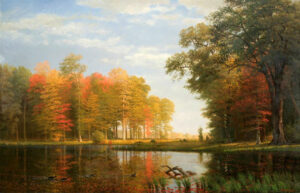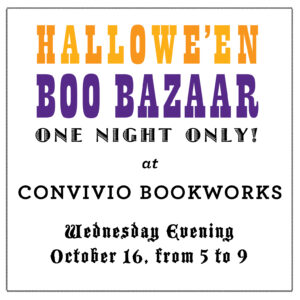You had probably given up, by now, on any hopes of me delivering news of the Convivio Book of Days Calendar for the month, and yet, here it is. To be honest, it’s been there for quite a while; I’ve just not had a moment to sit down to write and let you know. Be that as it may, I am doing so now. Our cover star this month: “Autumn Woods” and the radiancy that only October brings. Since the month’s beginning we’ve already celebrated Rosh Hashanah and the Feast of the Guardian Angels and the Feast of St. Francis of Assisi, with its accompanying blessings of animals (my favorite example this year involved Isabella Rossellini driving two sheep to church in the back of her car), not to mention Yom Kippur and St. Denis’ Day and Indigenous Peoples’ Day, and when you finally get word of this month’s calendar, it will be smack dab in the middle of the month, the 15th of October, which, this year, happens to be Apple Tuesday: a fine day, I think, to enjoy one of those lovelier fruits of the season.
There is much of October still to come, but my favorite of it, of course, is Hallowe’en, which closes the month, and begins our annual season of remembrance. And I know Hallowe’en can be problematic –– not all of you love it as we do here in this house –– but I would like to emphasize that there are two approaches to Hallowe’en and if you are not a fan of this wonderful night, might I suggest that perhaps you’ve been too immersed in the approach that has somehow evolved “spooky” and “spirited” and “mysterious” into axe-wielding murderers and gore and horror. I’m not a fan of that stuff, either. But I choose to exclude it from my Hallowe’en celebration, because it is not quite what the season is all about, is it?
Hallowe’en –– and I do think that apostrophe is gravely important –– is All Hallows Eve. It is remembrance: the first night of a season of remembrance that continues on to St. Martin’s Day on the Eleventh of November. Bring on the mystery and bring on the connexions across time and space and yes, to me, a bit of spookiness is most certainly welcome. Our Hallowe’en, in the odd house that is my memory, is fiddles and barn dancing and perhaps a quilting frolic with a table groaning with autumnal bounty and then, after dinner, ghost stories by the fire. It is trick-or-treating, a journey through the night with fellow trick-or-treaters, a night filled with mysterious sights and sounds. There are sweets –– and plenty of them –– but there are also concord grapes and sputtering baked apples and roasted nuts. In my family tradition, it is the time of year when we make a sacred, penitential dessert that our grandparents made, as did their parents and grandparents before them, since time immemorial. We eat this dessert only this time of year, especially on All Souls Night, and it is made from cooked wheat grains, pomegranate, chopped toasted almonds, and chopped chocolate, all mixed in a bowl and then covered in a syrup that was traditionally made from the last pressings of the grapes from winemaking. The syrup is called Mosto Cotto in proper Italian, though in Lucera, the small city in Puglia from where this strange dish for All Souls Night originates, we call the syrup U Cutto, and the dessert itself we call Cicci Cutto. But that is the Lucerine dialect, just as mysterious as this dessert we eat once a year. The pomegranates surely come from the story of Persephone, who must return to the underground world each autumn, the same underground where our beloved dead reside, and the spices that warm the dessert –– cinnamon and cloves –– warm our hearts and place us firmly in autumn, too.
This, to me, is Hallowe’en. This is the mystery of this time of year, and one of our great joys of autumn.
COME SEE US!
We’ve got lots going on this time of year! Maybe one or more of these festive occasions will convince you to come on by and say hello. We love when you do.
BOO BAZAAR
Our Boo Bazaar at the end of September was such a joy, we’ve decided to do it one more time. Come on over to our Lake Worth Beach shop on Wednesday evening, October 16, from 5 to 9 PM for one last Hallowe’en shopping event this month. This BOO BAZAAR will feature great spooky shopping, mysterious music, and my sister’s homemade amazing Baked Apple Cider Doughnut Holes, plus tarot card readings and fortunes told by Madame Marie-Claire. The shop address is 1110 North G Street in Lake Worth Beach, FL 33460. Also take note: our shop, which is usually open on Saturdays from 11 to 4, will only be open for the Boo Bazaar this Wednesday evening, and then won’t reopen again until Saturday, November 9. We’ll be at the following festivals (rather than at the shop):
We return to OKTOBERFEST MIAMI for the event’s second weekend: this Friday, October 18 through Sunday, October 20. That’s at the German American Social Club in Miami. It’s their 67th Oktoberfest: the oldest Oktoberfest in Florida. We were there all last weekend. So much fun! I’ve still got “The Chicken Dance” in my head.
Soon after Oktoberfest, it’ll be time for FLORIDA DAY of the DEAD at Esplanade Park in Downtown Fort Lauderdale. Please note that for that festival, our pop-up shop will be located in a double tent at Esplanade Park where the festival begins, before it processes over to Revolution Live. As such, we are there earlier than other craft tents that will be at the second half of the event. Find our double tent at Esplanade Park from 3 to 8 PM.
AUTUMN SALE ONLINE
At our online store we’re offering $10 off your purchase of $85 or more, plus get free domestic shipping. Just use discount code PUMPKINHEAD at checkout. We’re still adding new items this time of year almost daily… in fact, our fall shipment of specialty foods, candies, and cookies has just arrived! You’ll find new items from Germany for Hallowe’en and Christmas, plus new Advent calendars and candles, too. We’ll be adding those specialty foods from Europe to the online shop very soon. Lots to see! CLICK HERE to shop.
HALLOWE’EN REAL MAIL FRIDAY
Finally, won’t you join me on Zoom for a special Real Mail Fridays letter writing social from the Jaffe Center for Book Arts? It happens to be on Thursday this week, not Friday (since I’ll be at Oktoberfest Miami on Friday), and the music will be a very special soundtrack comprised of the kind of mysterious Hallowe’en and autumnal music I like best. Perhaps you’l like it, as well. We begin at 2 Eastern and end at 5 Eastern and you are free to come and go as you please, but the music will be playing all three hours, save for the occasional break we take for a little chat amongst friends. Folks have been joining in lately from all over the US and Canada, plus Scotland, Romania, and the Philippines (our friend there comes to us from the future, since it is already the next day in her part of the world — how mysterious is that?). CLICK HERE to join us.




